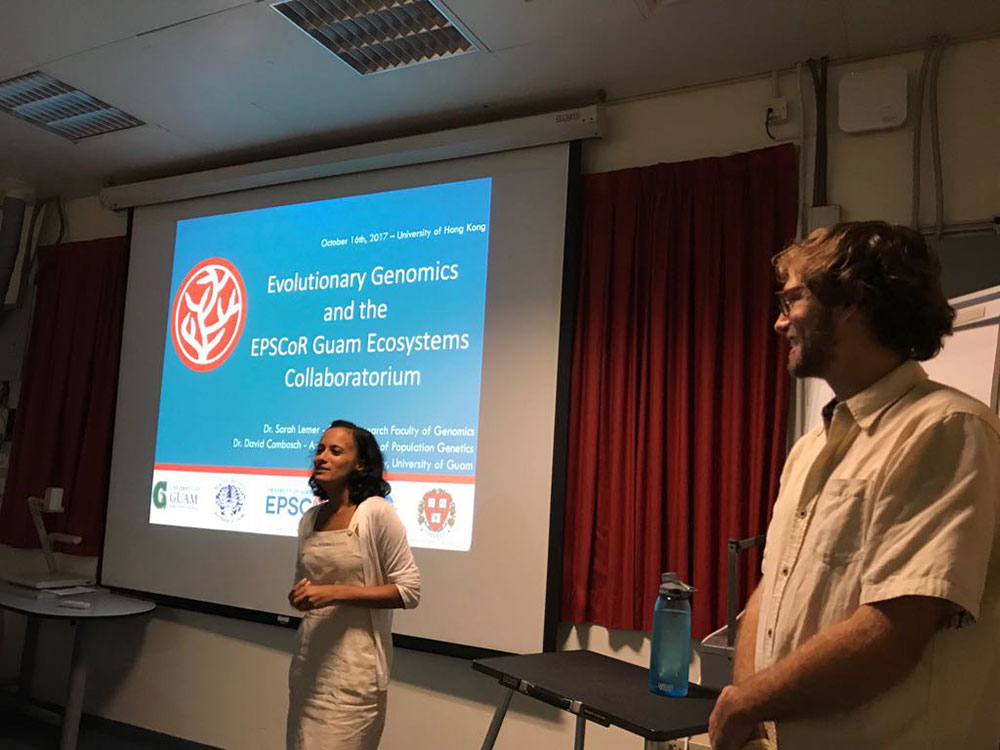- Home
-
Admissions
-
Academics
-
Students
-
Research
-
Research Centers
- Cancer Research Center
- Center for Excellence in Development Disabilities Education, Research & Service (CEDDERS)
- Center for Island Sustainability (CIS)
- Marine Laboratory
- Micronesian Area Research Center (MARC)
- UOG Land Grant | agInnovation Research Center
- Water and Environmental Research Institute (WERI)
-
Programs and Departments
- Guam EPSCOR
- Guma' Tinemtom - Micronesia Data Laboratory
- Pacific Islands Climate Adaptation Science Center (PI-CASC)
- Pacific Islands Cohort on Cardiometabolic Health (PICCAH)
- Research Corporation of UOG
- RFK Memorial Library
- UOG Press
- UOG Sea Grant
- University Libraries Digital Team
- NASA Guam Space Grant
- NASA Guam EPSCoR
-
Research Centers
-
Outreach
- Giving
- Alumni
-
About
UOG Faculty Share Cutting-Edge Genetic Research Approaches in Hong Kong
UOG Faculty Share Cutting-Edge Genetic Research Approaches in Hong Kong
UOG Faculty Share Cutting-Edge Genetic Research Approaches in Hong Kong
1/26/2018
 University of Guam Marine Laboratory Faculty, Dr. Sarah Lemer and Dr. David Combosch,
present at the University of Hong Kong’s Swire Institute of Marine Science.
University of Guam Marine Laboratory Faculty, Dr. Sarah Lemer and Dr. David Combosch,
present at the University of Hong Kong’s Swire Institute of Marine Science.
University of Guam Marine Laboratory (UOGML) faculty and Guam Ecosystems Collaboratorium (GEC) Researchers, Dr. Sarah
Lemer and Dr. David Combosch recently presented at the University of Hong Kong’s Swire
Institute of Marine Science about their ongoing efforts to characterize the bleaching
resilience of Guam’s reef corals.
Held on October 16, 2017 and organized by Dr. Dave Baker at the University of Hong
Kong’s School of Biological Sciences, the special guest seminar focused on Drs. Combosch
and Lemer’s participation in the GEC and their scientific approaches to exploring
the complex question of coral resiliency to environmental stress. Drs. Combosch and
Lemer discussed their approach of implementing a combination of research strategies
that includes fieldwork, molecular species differentiation, phylogenomics, population
genomics, and experimental gene expression assays.
“We’re using cutting-edge genomic tools and we’re asking questions that have not been
asked here before,” said Dr. Lemer. “With our newly implemented genomic facility,
we are now able to do everything on island, from sample collection, data generation
and analyses. Also, we enable students and our colleagues at the UOG Marine Laboratory
to use those tools and approaches for their own work.”
“The questions that we’re asking are highly relevant and urgently required for local
conservation and management,” said Dr. Combosch. “For example, we study the dispersal
scales of marine organisms, which has important implications for the resilience of
local populations and ecosystems and their ability to recover after disturbances,
which is fundamental for an informed design of marine protected areas.”
The GEC was formed in 2015 in the aftermath of the island experiencing its largest
coral bleaching event in 2013. At the time researchers had noted a difference in bleaching
susceptibility among the affected coral species and populations. Today GEC Researchers
seek to understand what accounts for the differences observed by studying the genetics
of coral species around Guam. This insight will inform local, regional, and global
conservation efforts and coral research and is made possible through the University
of Guam’s Established Program to Stimulate Competitive Research (EPSCoR) program,
a $6 million grant award from the National Science Foundation (NSF).
Recent News
No items to display
